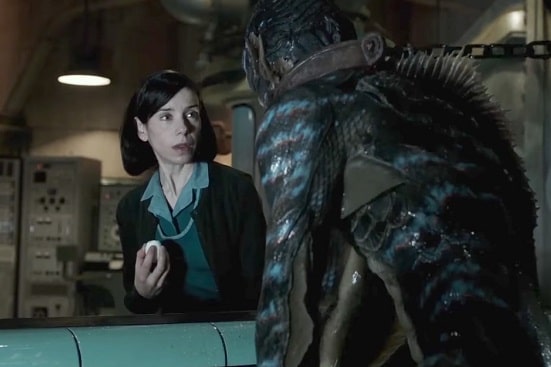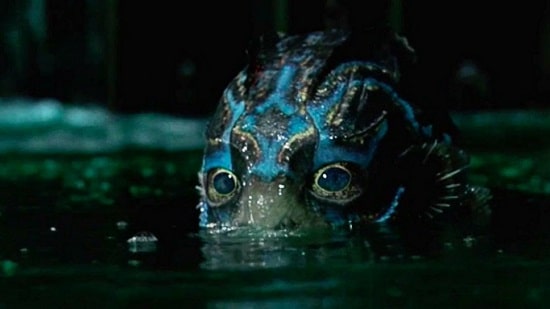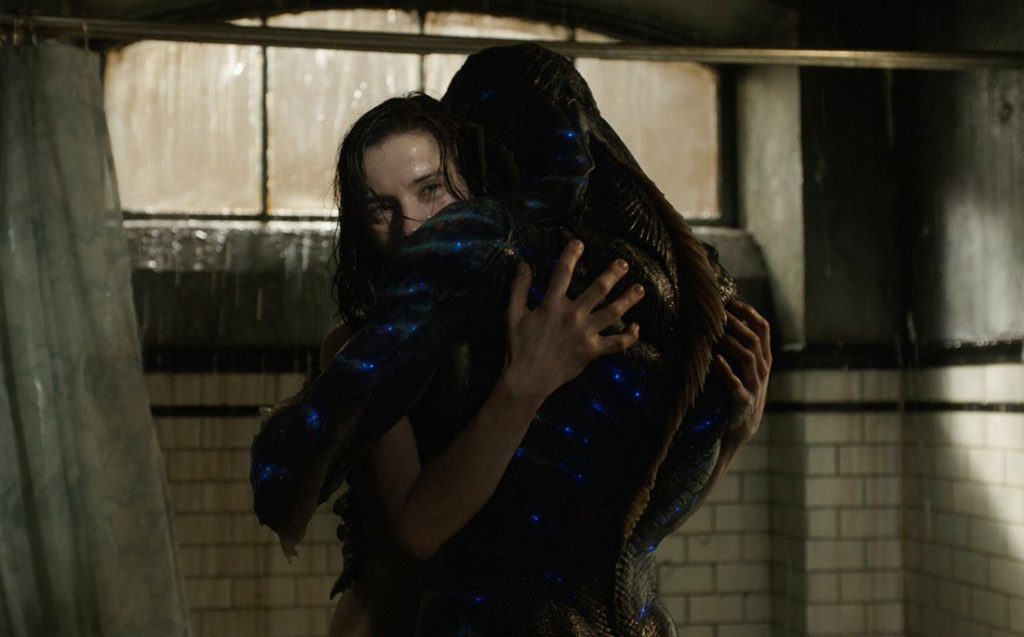 To say that this film arrives with a weight of expectation on its shoulders is putting it mildly. For starters, The Shape of Water is the latest film from Guillermo del Toro, widely regarded one of the greatest, most singular cinematic visionaries of our time, not to mention one of my own personal favourite filmmakers working today, and it’s already landed him a Best Director Golden Globe and a slew of Oscar nominations. After a couple of minor misfires (personally I love 2013’s Pacific Rim despite its many obvious flaws, although I struggle to see 2015’s Crimson Peak as anything but an interesting failure), The Shape of Water sees del Toro back away from the mega-budget realm and return to the comparatively smaller-scale independent arena in which he has arguably produced his best work: 2001’s The Devil’s Backbone and 2006’s Pan’s Labyrinth. By contrast with those Spanish productions set against the Spanish Civil War, this one is an English language US production set against the Cuban Missile Crisis, but in common with these it blends harsh reality with fairy tale in a heartfelt manner, which seems to have resonated widely with critics and audiences thus far.
To say that this film arrives with a weight of expectation on its shoulders is putting it mildly. For starters, The Shape of Water is the latest film from Guillermo del Toro, widely regarded one of the greatest, most singular cinematic visionaries of our time, not to mention one of my own personal favourite filmmakers working today, and it’s already landed him a Best Director Golden Globe and a slew of Oscar nominations. After a couple of minor misfires (personally I love 2013’s Pacific Rim despite its many obvious flaws, although I struggle to see 2015’s Crimson Peak as anything but an interesting failure), The Shape of Water sees del Toro back away from the mega-budget realm and return to the comparatively smaller-scale independent arena in which he has arguably produced his best work: 2001’s The Devil’s Backbone and 2006’s Pan’s Labyrinth. By contrast with those Spanish productions set against the Spanish Civil War, this one is an English language US production set against the Cuban Missile Crisis, but in common with these it blends harsh reality with fairy tale in a heartfelt manner, which seems to have resonated widely with critics and audiences thus far.
It’s a film I’ve been anxious to see ever since it was first announced, and the near-ecstatic reactions online inevitably left me feverish with anticipation… and, alas, these are not always the best conditions under which to see a film. For now, as I reflect on The Shape of Water, I whole-heartedly agree with the consensus view that it’s a beautiful piece of cinema that is very well-acted, with an agreeably optimistic message that might very well be necessary in these increasingly bleak times. Yet even so, I haven’t fallen head over heels in love with the film as so many others seem to have. I found it impressive, entertaining and highly thought-provoking, yet not so deeply moving as del Toro and company clearly intended it to be.
 The brilliant Sally Hawkins takes the lead as Elisa, a mute woman who lives alone in a humble apartment above a cinema in Baltimore, next door to advertising illustrator Giles (a very likeable Richard Jenkins). Elisa works nights as a cleaner in a high security science lab, where she is close friends with co-worker Zelda (an endearing, if comparatively under-developed Octavia Spencer). Naturally it’s a pretty dull existence, but one day things get very interesting with the arrival of what they’re told is an extremely rare, valuable and sensitive ‘asset’ – which turns out to be a never-before-seen amphibian man (Del Toro’s go-to creature actor Doug Jones), fished out of the Amazon river. Along with the ‘asset’ comes a wealth of new security, headed up by stern military man Strickland (a wonderfully nuanced and sinister Michael Shannon). Even so, with a little sneakiness Elisa has no difficulty getting close to the enigmatic creature, and with each visit the two find themselves increasingly fascinated with one another. So when Elisa gets wind of plans for the creature to be put to death, she quickly cooks up a plan to free her strange new friend – for whom, it soon becomes clear, her feelings go beyond mere friendship.
The brilliant Sally Hawkins takes the lead as Elisa, a mute woman who lives alone in a humble apartment above a cinema in Baltimore, next door to advertising illustrator Giles (a very likeable Richard Jenkins). Elisa works nights as a cleaner in a high security science lab, where she is close friends with co-worker Zelda (an endearing, if comparatively under-developed Octavia Spencer). Naturally it’s a pretty dull existence, but one day things get very interesting with the arrival of what they’re told is an extremely rare, valuable and sensitive ‘asset’ – which turns out to be a never-before-seen amphibian man (Del Toro’s go-to creature actor Doug Jones), fished out of the Amazon river. Along with the ‘asset’ comes a wealth of new security, headed up by stern military man Strickland (a wonderfully nuanced and sinister Michael Shannon). Even so, with a little sneakiness Elisa has no difficulty getting close to the enigmatic creature, and with each visit the two find themselves increasingly fascinated with one another. So when Elisa gets wind of plans for the creature to be put to death, she quickly cooks up a plan to free her strange new friend – for whom, it soon becomes clear, her feelings go beyond mere friendship.
As has been noted, it’s curious to think that The Shape of Water is in many respects rooted in del Toro’s own ideas for a remake of The Creature From The Black Lagoon, which he had at one point been attached to. This, of course, is far from the only way in which the film harks back to del Toro’s past; the Amphibian Man (as he is officially credited) is clearly similar, both in his appearance and his fondness for eggs, to Hellboy supporting character Abe Sapien, who was also portrayed by Doug Jones. We might, then, declare The Shape of Water to be pure Guillermo del Toro, a film that only this specific filmmaker could have made which bears his unmistakable signature; and yet, in many respects it’s aesthetically and thematically reminiscent of Jean-Pierre Jeunet, a feeling strengthened by Alexandre Desplat’s enormously Gallic soundtrack (not that Desplat ever scored a Jeunet movie). It feels rather unlike an American film – but then, that’s almost certainly the point. Here we have a film with a largely French aesthetic from a Mexican director, with an English actress in the lead, playing a mute woman whose best friends are an old gay man and a black woman, who ultimately falls in love with a half-man half-fish. It’s screamingly obvious that this is a film about challenging bigotry in all its forms, and communicating across all social boundaries.
And yet, despite the obvious audacity of its central conceit, The Shape of Water does not come across as an especially transgressive film. It does not set out to shock the audience; indeed, in this it stands apart from del Toro’s earlier films, as even its most violent and bloody moments fall short of the brutality of Pan’s Labyrinth or even Crimson Peak. Nor, beyond one brief scene between Hawkins and Spencer, is the essentially bestial love story ever played for laughs. In common with all del Toro’s most personal films, The Shape of Water is an entirely sincere attempt to evoke the simple, direct approach of fables and fairy tales, with the key message that we should not fear that which is different from ourselves. As such, it’s only fitting that the film treats its central love story – including, gasp, its sexual elements – without judgement. Beyond a few comparatively mild moments in Crimson Peak, Del Toro hasn’t handled sexuality this frankly before, and it’s fascinating and refreshing that these sequences do not in any way come off salacious or voyeuristic. Sex is presented is something entirely natural, even innocent – even when it’s happening between creatures who are not quite the same species.
 On paper, it’s very hard to believe such material can be played entirely straight, but it really is. This, perhaps, is where some viewers may struggle to fully embrace The Shape of Water, much as I have. While the film takes place in a version of our world, set against the darkest days of the Cold War, it’s still very much a (for want of a better word) heightened work of cinematic fantasy which does not endeavour to follow real world logic. As such, we have to accept the slightly stilted nature of some of the dialogue and character work; we have to overlook concerns about just how Elisa is so easily able to shirk work and spend time with supposedly the most closely guarded scientific find of the era, let alone how she’s able to smuggle in a record player unnoticed. We have to accept how often the action hinges on convenient coincidences, and the surprisingly whimsical turns taken here and there, most notably with a few impassioned homages to classic musical cinema. We have to accept all this by reverting to a simpler means of comprehension such as we had when reading fairy tales as children, or when watching The Wizard of Oz; we have to keep in this mindset even when the film tackles more mature and realistic subject matter. Some viewers, like me, may have some difficulty getting on that wavelength, although I find it strangely encouraging that I seem to be in the minority there.
On paper, it’s very hard to believe such material can be played entirely straight, but it really is. This, perhaps, is where some viewers may struggle to fully embrace The Shape of Water, much as I have. While the film takes place in a version of our world, set against the darkest days of the Cold War, it’s still very much a (for want of a better word) heightened work of cinematic fantasy which does not endeavour to follow real world logic. As such, we have to accept the slightly stilted nature of some of the dialogue and character work; we have to overlook concerns about just how Elisa is so easily able to shirk work and spend time with supposedly the most closely guarded scientific find of the era, let alone how she’s able to smuggle in a record player unnoticed. We have to accept how often the action hinges on convenient coincidences, and the surprisingly whimsical turns taken here and there, most notably with a few impassioned homages to classic musical cinema. We have to accept all this by reverting to a simpler means of comprehension such as we had when reading fairy tales as children, or when watching The Wizard of Oz; we have to keep in this mindset even when the film tackles more mature and realistic subject matter. Some viewers, like me, may have some difficulty getting on that wavelength, although I find it strangely encouraging that I seem to be in the minority there.
I get the feeling it’s going to take another viewing or two for me to fully process The Shape of Water; indeed, I considered delaying this review until I’d seen it a second time, in hopes of laying my uncertainties to rest. While, as of right now, it hasn’t entirely swept me away, I can still happily declare The Shape of Water a triumphant, beautiful film with excellent performances, which richly deserves to be seen and talked about. To my mind, though, Del Toro’s true masterpiece remains Pan’s Labyrinth.
The Shape of Water is in UK cinemas on Wednesday 14th February, from Fox Searchlight.
